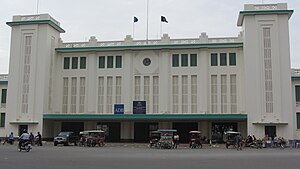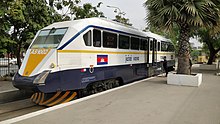
The system of transport in Cambodia, rudimentary at the best of times, was severely damaged in the chaos that engulfed the nation in the latter half of the 20th century. The country's weak transport infrastructure hindered emergency relief efforts, exacerbating the logistical issues of procurement of supplies in general and their distribution. Cambodia received Soviet technical assistance and equipment to support the maintenance of the transportation network.

Pol Pot was a Cambodian revolutionary and politician who was the dictator of communist Cambodia from 1976 until his overthrow in 1979. He oversaw mass atrocities and is widely believed to be one of the most brutal despots in modern world history. Ideologically a Maoist and a Khmer ethnonationalist, Pot was a leader of Cambodia's Communist movement, known as the Khmer Rouge, from 1963 to 1997. He served as General Secretary of the Communist Party of Kampuchea from 1963 to 1981, during which Cambodia was converted into a one-party state. Between 1975 and 1979, Pot perpetrated the Cambodian genocide, in which an estimated 1.5–2 million people died—approximately one-quarter of the country's pre-genocide population. In December 1978, Vietnam invaded Cambodia to remove the Khmer Rouge from power. Within two weeks, Vietnamese forces occupied most of the country, ending the genocide and establishing a new Cambodian government, with the Khmer Rouge restricted to the rural hinterlands in the western part of the country.

Phnom Penh is the capital and most populous city of Cambodia. It has been the national capital since the French protectorate of Cambodia and has grown to become the nation's primate city and its economic, industrial, and cultural centre. Before Phnom Penh became capital city, Oudong was the capital of the country.
Articles related to Cambodia and Cambodian culture include:

Banteay Meanchey is a province of Cambodia located in the far northwest. It borders the provinces of Oddar Meanchey to the north, Siem Reap to the east, Battambang to the south, and shares an international border with Thailand to the west. Its capital and largest city is Serei Saophoan.

Poipet is a city on the Cambodian–Thai border, in Poipet Municipality, Banteay Meanchey Province. It is a key crossing point between the two countries, and also extremely popular as a gambling destination as gambling is popular, but mostly illegal in Thailand.
Battambang is the capital of Battambang Province and the third largest city in Cambodia.
Media in Cambodia is largely unregulated and includes radio, television and print media outlets. Private sector companies have moved into the media sector, which represents a change from years of state-run broadcasting and publishing.

The National Television of Cambodia is the national television station of Cambodia. It is owned and operated by the government of Cambodia in Phnom Penh together with the national radio station, National Radio of Cambodia. TVK is member of the Asia-Pacific Broadcasting Union (ABU).

Mongkol Borey is a district (srok) in the south of Banteay Meanchey Province, in northwestern Cambodia. The district capital is the town of Mongkol Borey, around nine kilometres south of the provincial capital of Serei Saophoan by road. The district shares a border with Battambang Province to the south. The main railway line from Phnom Penh to Poipet on the border with Thailand runs through the district from north to south.

Serei Saophoan is a municipality (krong) in the centre of Banteay Meanchey province, in north-western Cambodia. Serei Saophoan is the urban district of Banteay Meanchey province and the district capital is also the provincial capital Sisophon town. The town is located 359 kilometres north of Phnom Penh and 48 kilometres from the border with Thailand at Poipet. Serei Saophoan municipality is the central municipality of Banteay Meanchey and is surrounded by other Banteay Meanchey districts. Cambodia's main railway line from Phnom Penh to Poipet enters the municipality from the south and exits to the west.

Malai is a district (srok) in the south west of Banteay Meanchey Province, in north-western Cambodia. The district capital is the town of Malai located around 75 kilometres west of the provincial capital of Serei Saophoan by road.
The Don Bosco Foundation of Cambodia is a Non-profit organization of education founded in Cambodia in 1991 to give technical skill education to youth living in extreme poverty and to facilitate the schooling of marginalized children. The organization was a way to answer the needs of a country in its post-war period of reconstruction. DBFC is a branch of the Salesians of Don Bosco. The United Nations asked to the Salesians in Thailand to attend the children and youth of the Cambodian Refugee camps during the 1980s. DBFC answered this request by opening provisional technical schools in the camps. After the peace agreements, the organization was invited by the Cambodian government to settle in the country. The first printing press in Cambodia after the war, was provided by DBFC in the Don Bosco Technical School of Phnom Penh for the republishing, translating and writing of books and documents of education. Many schools were rebuilt in the villages and the Organization gained prestige as the first institution to provide technical education and to offer sponsorship to Cambodian children.
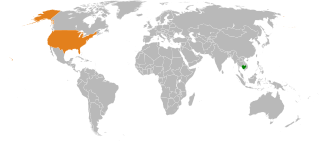
Bilateral relations between the United States and Cambodia, while strained throughout the Cold War, have strengthened considerably in modern times. The U.S. supports efforts in Cambodia to combat terrorism, build democratic institutions, promote human rights, foster economic development, and eliminate corruption.

Cambodia has 612 km (380 mi) of 1,000 mm metre gauge rail network, consisting of two lines: one from the capital, Phnom Penh, to Sihanoukville, and another from Phnom Penh to Poipet, on the Thai border. The lines were originally constructed during the time when the country was part of French Indochina, but due to neglect and damage from civil war during the latter half of the 20th century, the railways were in a dilapidated state, and all services had been suspended by 2009. Through rehabilitation efforts by the government of Cambodia, with funding from the Asian Development Bank, Australian Agency for International Development (AusAID), and the Australian company Toll Holdings, freight and limited passenger service returned between Phnom Penh and Sihanoukville by 2016, and passenger service between Phnom Penh and Poipet was fully restored in 2019.
The Samlaut uprising, also called the Samlaut rebellion or Battambang revolts, consisted of two significant phases of revolt that first broke out near Samlaut in Battambang Province and subsequently spread into surrounding provinces of Cambodia in 1967-1968. The movement was largely made up of dissident rural peasantry led by a group of discontented leftist intellectuals against Prince Norodom Sihanouk’s political organization, the Sangkum regime.
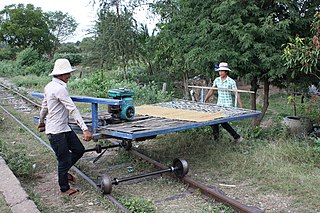
A norry or nori was an improvised rail vehicle service from Cambodia. Lonely Planet describes it as "Cambodia's bamboo train". The trains ran at speeds of up to 50 km/h (31 mph) on the metre gauge tracks around Battambang and Poipet. A scheduled service run by the Government also operates, but is slower at 30 km/h (19 mph). The rest of the network, originally built by the French colonial government, is largely abandoned, after the Khmer Rouge regime effectively shut it down. In 2006 the BBC reported that there was only one scheduled service a week and it ran at not much more than walking pace.

The Communist Party of Kampuchea (CPK), also known as the Khmer Communist Party, was a communist party in Cambodia. Its leader was Pol Pot, and its members were generally known as the Khmer Rouge. Originally founded in 1951, the party was split into pro-Chinese and pro-Soviet factions as a result of the Sino–Soviet split with the former being the Pol Pot faction, and the latter adopting a more revisionist approach to Marxism. As such, it claimed that 30 September 1960 was its founding date; it was named the Workers' Party of Kampuchea before it was renamed the Communist Party in 1966.
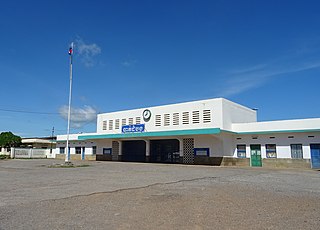
Battambang Royal railway station is a railway station in Battambang, the capital city of Battambang province in northwestern Cambodia. It was opened in 1953 and is operated by Royal Railways of Cambodia.
